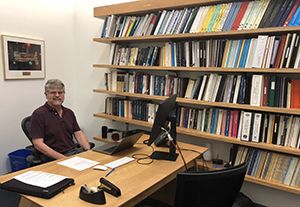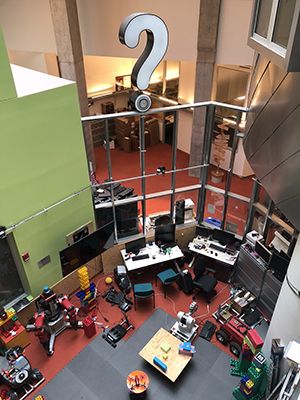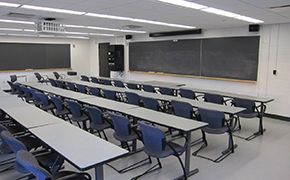Instructor Insights pages are part of the OCW Educator initiative, which seeks to enhance the value of OCW for educators.

Aeronautics and Astronautics Professor Brian Williams in his office on the MIT campus. (Image by MIT OpenCourseWare.)
Below, Professor Brian Williams describes various aspects of how he teaches 16.412 Cognitive Robotics.
OCW: What is cognitive robotics?
Brian Williams: Artificial intelligence focuses on how people reason consciously. In cognitive robotics, we focus on developing robots that can think at the level that humans do. As humans, we’re good at planning and executing tasks. Researchers working in the field of cognitive robotics focus on giving robots these abilities, too. But nothing ever goes like you expect. Humans constantly adapt. We try to create robots that can adjust their goals and develop contingencies. So the main things that students learn in the course are how to plan systems dynamically, and how to monitor and diagnose problems with cognitive robots. Students also learn how to program these systems.
OCW: How is learning different in a course focused on an emerging field like cognitive robotics?
Brian Williams: Students are accustomed to reading chapters in textbooks—material that took decades for scientists to understand. But cognitive robotics is an active research area. It’s moving so quickly that every three years or so it reinvents itself. This course is focused on helping students close the gaps in the research. To be at the cutting edge of research, students need to read across papers and understand core ideas that are developed from a collection of publications. And then they need to be able to reduce that understanding to practice.
There’s also no better way to understand something than to teach it, implement it, and put it in a bigger context of some real-world application. That’s why we have a grand challenge at the center of the course experience.
I want (students) to learn that, as scientists, their role is to consolidate ideas and to teach the community.
— Brian Williams
OCW: Tell us more about the grand challenge.
Brian Williams: I like the idea of learning communities, of everybody trying to learn about a topic together. The grand challenge is a communal learning experience driven by a cutting-edge research question in cognitive robotics that allows us to focus on core reasoning algorithms. Students work in teams to present advanced lectures about different aspects of the topic.
OCW: Why teams?
Brian Williams: It’s important for students to work in teams because research is a collaborative endeavor. The notion that doctoral students are lone wolves is just not accurate. The more students can practice effective collaboration, the better.
It’s also the case that developing lectures is hard work. Just producing a first draft of a lecture can take 20 to 30 hours. And then you need to spend another 6 hours improving it. So, to develop a high-quality lecture, you really need two people working together.

Domo Robot, developed by Aron Edsinger and Jeff Weber, is able to adapt to novel situations. It is on display in the MIT Computer Science and Artificial Intelligence Lab. (Image by MIT OpenCourseWare.)
OCW: Are there other components of the grand challenge, in addition to the advanced lectures?
Brian Williams: Yes. As I mentioned, the field of cognitive robotics is moving really fast. What normally happens is that members of the research community will generate tutorials on emerging themes. These tutorials encapsulate core ideas that everybody should know. The problem is that there’s just so much we need to know—but not enough time to write all the tutorials. So some of the students in the class are assigned to write tutorials related to the topic of the grand challenge. And a few others will write corresponding Jupiter or Python notebook problem sets. Along with the lectures, students end up producing materials that are enormously helpful to researchers in the field. This is important because I want them to learn that as scientists, their role is to consolidate ideas and to teach the community.
OCW: Have you encountered a grand challenge in your own career?
Brian Williams: The first grand challenge I encountered was during my time at NASA. They had just lost a billion dollar Mars mission. The spacecraft stopped working and the humans on the ground couldn’t control it. The NASA administrator asked us to build a spacecraft that could do the thinking that the ground crew should have done to ensure the safety of the spacecraft. It was an interesting example of a visionary challenge. It was exciting. We learned a huge amount from that challenge. It drove research in the field for about 10 years.
OCW: You don’t talk about competition when you discuss grand challenges.
Brian Williams: Probably deep down, I am not so driven by competition, which is one way for research to advance. My experience at NASA taught me that grand challenges are about people working together to tackle a big problem that nobody knows how to do. In academia, we often have competitions when we know there are a number of ways to approach a problem. In these situations, scientists are driven by the challenge of examining the details of the problem. But grand challenges focus on an earlier stage of research—one in which people don’t know even one way to solve the problem.
› Read More/Read Less
Curriculum Information
Prerequisites
6.041 Probabilistic Systems Analysis and Applied Probability, 6.042 Mathematics for Computer Science, or 16.09 Statistics and Probability.
16.410 Principles of Autonomy and Decision Making, 6.034 Artificial Intelligence, or 6.825 Techniques in Artificial Intelligence
Requirements Satisfied
16.412 Cognitive Robotics can be applied toward a doctorate degree in Aeronautics and Astronautics.
Offered
Every spring semester
Assessment
Grade Breakdown
The students' grades were based on the following activities:
 10% Participation & attendance (mini quizzes) 10% Participation & attendance (mini quizzes) 40% Problem sets 40% Problem sets 30% Advanced lecture & implementation 30% Advanced lecture & implementation 20% Grand challenge 20% Grand challenge |
Student Information

Breakdown by Year
Mostly first and second year graduate students, a few undergraduate students.
Breakdown by Major
Variety of majors
Typical Student Background
Students come to the course with a variety of interests, but all are passionate about some notion of robotic systems. Students from the Media Lab have explored smart kitchens and smart buildings. Other students are curious about underwater vehicles, while some are drawn to smart cars. Whatever a computer can make a little smarter—that’s what interests them.
During an average week, students were expected to spend 12 hours on the course, roughly divided as follows:
In Class
- Met 2 times per week for 1.5 hours per session; 25 sessions total.
- Sessions included advanced lectures, delivered by students, on topics related to the grand challenge.
- Some sessions include mini-quizzes to assess students’ understanding of content.
Out of Class
- Students completed required readings and worked on problem that asked them to perform modeling exercises, using existing autonomy tools, and implement algorithms (sometimes from scratch).
Semester Breakdown
| WEEK | M | T | W | Th | F |
|---|---|---|---|---|---|
| 1 |  |  |  |  |  |
| 2 |  |  |  |  |  |
| 3 |  |  |  |  |  |
| 4 |  |  |  |  |  |
| 5 |  |  |  |  |  |
| 6 |  |  |  |  |  |
| 7 |  |  |  |  |  |
| 8 |  |  |  |  |  |
| 9 |  |  |  |  |  |
| 10 |  |  |  |  |  |
| 11 |  |  |  |  |  |
| 12 |  |  |  |  |  |
| 13 |  |  |  |  |  |
| 14 |  |  |  |  |  |
| 15 |  |  |  |  |  |
| 16 |  |  |  |  |  |
 No classes throughout MIT
No classes throughout MIT Class session
Class session Problem set due
Problem set due No class session scheduled
No class session scheduled Advanced lecture
Advanced lecture Grand challenge implementation
Grand challenge implementation


 Room 1 of 1
Room 1 of 1 